Gideon Summerfield meets Holocaust survivors
19 year old illustrator and visual artist Gideon Summerfield met a group of Holocaust survivors.
Gideon produced a set of portraits featuring Holocaust survivors and their children or grandchildren. Including the children and grandchildren – the ‘second and third generation’ – is an important part of Gideon’s approach as, for many years, a number of survivors did not talk to their families about their horrific experiences. The younger generation now know a great deal about what happened but as the years go by, the survivors will not be present to share their stories and it will fall to the next generation and their children to keep the memory alive. Gideon’s project aims to capture each individual as fully and faithfully as possible through intricate line drawings and portraits, to depict his subjects as they are today – with one eye on what they experienced in the past.
Here are Gideon’s drawings in response to the Holocaust survivors’ experiences
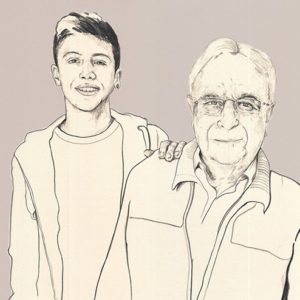 Jan Goldberger was born in the town of Bielsko Biala in South-West Poland in 1927. He attended a local Jewish school until the war broke out, when he and his family fled East in the direction of the Russian border. After the Germans caught up with his family and told them to return home, they walked back again, till they reached Topola. Jan and his family were offered shelter for two winters until the Jews were ordered into the nearest town, Skalbmiez. Jan and his father were separated from the rest of the family and during the winter of 1941-42 he was taken to Plaszow concentration camp.
Jan Goldberger was born in the town of Bielsko Biala in South-West Poland in 1927. He attended a local Jewish school until the war broke out, when he and his family fled East in the direction of the Russian border. After the Germans caught up with his family and told them to return home, they walked back again, till they reached Topola. Jan and his family were offered shelter for two winters until the Jews were ordered into the nearest town, Skalbmiez. Jan and his father were separated from the rest of the family and during the winter of 1941-42 he was taken to Plaszow concentration camp.
He then was transported to several camps including Skarzysko, Buchenwald, Schileben and Theresienstadt where he was liberated on the 8th May 1945. He arrived in England on 14th August 1945 and became a tailor and owned a hotel business. Today Jan has three children and five grandchildren. In the portrait Jan is joined by his eldest grandson Eden who is studying at West Herts College. Jan’s hand rests on his mother’s birth certificate which is the only physical possession he has left of his mother.
Zigi Shipper was born in Lodz, Poland in 1930. He lived with his father and his paternal grandparents as his parents were divorced. He attended a Jewish school that was in the same building where he lived and it was a happy childhood. In 1939 the Germans invaded and within a short time a decree was issued stating that all 150,000 Jews had to leave their homes and live in a designated area, the Lodz ghetto. He had to share one room with no bathroom with his grandfather and grandmother. In July 1944 the Germans liquidated the ghetto and Zigi was sent to Auschwitz concentration camp.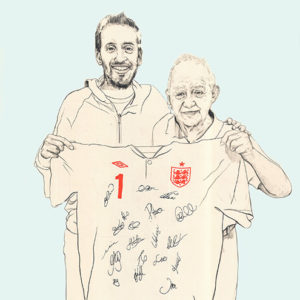
In November 1944 he was transported to another smaller camp called Stuthoff. In May 1945 the British Army liberated him and others who had survived and he was flown to England. Zigi began a new life and owned two printing shops. In the portrait Zigi appears with his son Robert. They are holding a signed England football shirt that was presented to Zigi by the England football team, prior to their visit to Auschwitz concentration camp at the time of the UEFA football championship in 2012 in Poland.
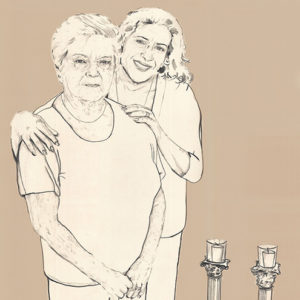 Rachel Levy was born in former Czechoslovakia. She was sent to Auschwitz along with her family. Her mother, sisters and younger brother were taken straight to the gas chambers. Rachel managed to survive until the camp was liberated in May 1945. She did not speak about her traumatic ordeal for 50 years. In England she became a dressmaker on Bond Street in London. Rachel’s older brother also managed to survive the Holocaust but was terribly ill.
Rachel Levy was born in former Czechoslovakia. She was sent to Auschwitz along with her family. Her mother, sisters and younger brother were taken straight to the gas chambers. Rachel managed to survive until the camp was liberated in May 1945. She did not speak about her traumatic ordeal for 50 years. In England she became a dressmaker on Bond Street in London. Rachel’s older brother also managed to survive the Holocaust but was terribly ill.
When he reached the UK he was one of the first to have heart surgery by Professor Sir Madgi Yacoub. Recently Rachel took some of her family back to where she was born. Her personal background and experience at Auschwitz is something very important to her and she regularly speaks in schools to educate young people about the Holocaust. In the portrait Rachel appears with her daughter Shelley Irvine. Her son has two grandchildren who live in California.
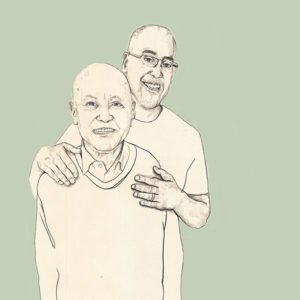 Victor Greenberg grew up in the village of Majdan, Slovakia. In 1941 he and his family were among the very few to escape when almost the entire Jewish population of the town was massacred, but in 1944 they were transported to Auschwitz. Victor’s family were murdered but he survived to be transported to Matthausen, Guzen, and Gunkirchen where he was liberated by the Americans.
Victor Greenberg grew up in the village of Majdan, Slovakia. In 1941 he and his family were among the very few to escape when almost the entire Jewish population of the town was massacred, but in 1944 they were transported to Auschwitz. Victor’s family were murdered but he survived to be transported to Matthausen, Guzen, and Gunkirchen where he was liberated by the Americans.
Victor arrived in Britain in 1946 where he began a new life manufacturing costume jewellery. He was a member of the Primrose Jewish Youth Club where he enjoyed playing football and table tennis with other Holocaust survivors known as ‘The Boys’. Victor has been married 52 years to Tina and he has two sons, a daughter and nine grand-children. In the portrait Victor is accompanied by his son David Greenberg, a solicitor.
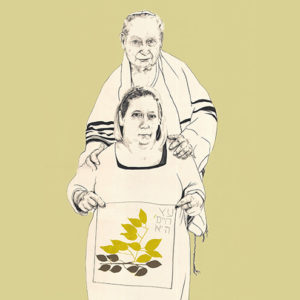 Solly Irving was born in Poland and was nine years old when the war broke out. He was the only survivor from his large, orthodox family. His parents and four sisters were all killed. Solly spent time in a number of different camps including a year in Buchenwald death camp. At the age of 14 he was liberated from Theresienstadt Camp in May 1945.
Solly Irving was born in Poland and was nine years old when the war broke out. He was the only survivor from his large, orthodox family. His parents and four sisters were all killed. Solly spent time in a number of different camps including a year in Buchenwald death camp. At the age of 14 he was liberated from Theresienstadt Camp in May 1945.
He was one of the first survivors to arrive in England and joined the ’45 Aid Society’ known as the ‘Boys’. Solly has two children, four grandchildren and two great-grandchildren. In the portrait he is joined by his daughter Hazel who works at Kisharon, a school in London that supports children who have learning difficulties.
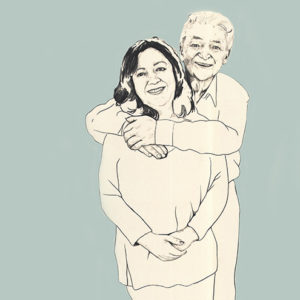
Harry Spiro was born in the town of Piotrków, which in October 1939 became the first ghetto set up by the Nazis in Poland. One day with 3,000 other Jewish prisoners Harry was relocated from Rehmsdorf labour camp to Theresienstadt in Czechoslovakia.
After the war, Harry became one of 732 Jewish Holocaust survivors known as “the Boys” who came to start new lives in the Lake District. He says “We had to make a life. We had to get a job and learn the language. I did all that.” Harry is married to Pauline and has three children and nine grandchildren. He became a tailor. In the portrait Harry is accompanied by his daughter Tracy.
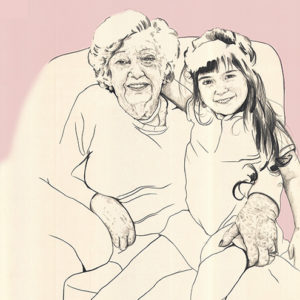
Minia Jay was born in Warsaw, Poland, in 1926. She was sent to the Warsaw Ghetto, the Lodz Ghetto and Auschwitz-Birkenau concentration camp and then to Theresienstadt where she was liberated in May 1945.
Arriving in England, Minia lived for several months in Windermere in the Lake District with other survivors, where she began to recover from TB. Minia has two children, six grandchildren and seven great grandchildren. In the portrait Minia is joined by her four year old great-granddaughter Hannah.
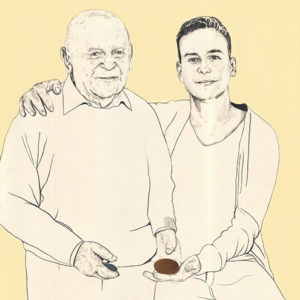
Ben Helfgott was born in Poland in 1929. During the Holocaust he was sent to several concentration camps, including Buchenwald. In 1945 Ben was sent to Theresienstadt – three weeks later the camp was liberated. Most of his family did not survive the Holocaust. After liberation Ben moved to the UK. He helped to establish a club for Jewish young people, called the Primrose Club, also known as ‘The Boys’.
He trained as a weightlifter, competing for Britain in two Olympic games in Melbourne in 1956 and Rome in 1960. He also competed in the 1958 Commonwealth Games in Cardiff where he won a bronze medal. Ben was captain of the British weightlifting team on all these occasions. He has three children and nine grandchildren. In the portrait Ben is joined by his grandson Sam, who studies at University College London. Ben has campaigned for Holocaust survivor groups, winning accolades and awards including an MBE and two honorary doctorates. They are both holding medals that Ben received at the Olympics in Melbourne and Rome.
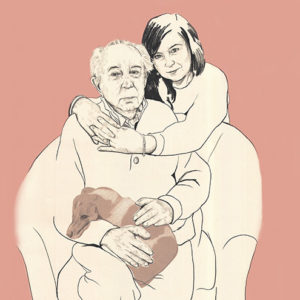 Sam Dresner was born in Warsaw, Poland in 1928. He was sent to Warsaw Ghetto, Magnuszew, Skarzysko, Buchenwald and then liberated during a death march from Theresienstadt near the end of the war. He was flown to England and became part of the Windermere group, like many of the other survivors.
Sam Dresner was born in Warsaw, Poland in 1928. He was sent to Warsaw Ghetto, Magnuszew, Skarzysko, Buchenwald and then liberated during a death march from Theresienstadt near the end of the war. He was flown to England and became part of the Windermere group, like many of the other survivors.
He then studied at The Heatherley School of Fine Art and Central School of Arts and Crafts. Sam then did further studying in Paris for around six months. He has had many jobs throughout the years but he has always been an artist. He has always been an admirer of Van Gogh. Today Sam has two children, and three grandchildren. In the portrait, Sam appears with his daughter Rachel, who is an art teacher and his dog, Jackie.